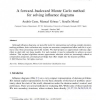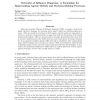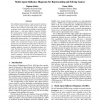63 search results - page 3 / 13 » Possibilistic Influence Diagrams |
IJAR
2006
13 years 7 months ago
2006
Although influence diagrams are powerful tools for representing and solving complex decisionmaking problems, their evaluation may require an enormous computational effort and this...
ATAL
2007
Springer
13 years 11 months ago
2007
Springer
This paper extends the framework of dynamic influence diagrams (DIDs) to the multi-agent setting. DIDs are computational representations of the Partially Observable Markov Decisio...
JAIR
2008
13 years 7 months ago
2008
This paper presents Networks of Influence Diagrams (NID), a compact, natural and highly expressive language for reasoning about agents' beliefs and decision-making processes....
IJCAI
2001
13 years 8 months ago
2001
The traditional representations of games using the extensive form or the strategic (normal) form obscure much of the structure that is present in real-world games. In this paper, ...
ATAL
2009
Springer
13 years 11 months ago
2009
Springer
Interactive dynamic influence diagrams (I-DIDs) are graphical models for sequential decision making in uncertain settings shared by other agents. Algorithms for solving I-DIDs fac...



